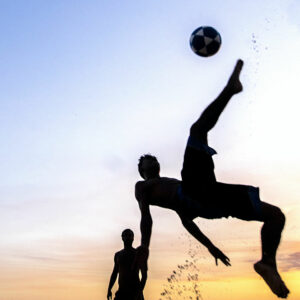Dreaming about the World Cup: Starting them young

(Part 2)
A young and growing population is the greatest asset of the Philippines in the field of economic development. Thanks to a population today of some 112 million people with a median age of 24, the Philippine economy is able to grow, despite the damage done by the pandemic and the ongoing global recession, at an average of 6% to 7% in GDP and could even grow faster at 8% to 10% if the administration of President Ferdinand Marcos, Jr. delivers on three fronts: increase agricultural production at an average of 2% to 3% annually in the next five to six years; increase the investment to GDP ratio to over 30% from a historical average of 22%; and significantly improve good governance and reduce corruption, both public and private.
The leading sources of growth on the income side are the remittances from the more than 10 million overseas Filipino workers abroad; the foreign exchange earnings of the business process outsourcing-information technology (BPO-IT) sector that employs 1.4 million today and is expected to add 1 million more workers in the next five to six years; and the booming tourism sector, jump started by domestic travel and to be boosted by foreign tourism two or three years from now. Because of our large domestic market, the Philippine economy is significantly insulated from the ups and downs of the export sector as the world goes from one recession to another.
It is also this demographic dividend that should make us confident, that with greater efforts on the part of the stakeholders of football as a national sport, we can emulate what two small countries like Croatia and Morocco have done in not only qualifying for the World Cup but in reaching the semi-finals in Qatar in 2022.
In fact, Croatia has qualified for every major tournament with the exception of Euro 2000 and 2010 World Cup, reaching the quarter finals of the UEFA European Championship twice (1996, 2008) and the semi-finals of UEFA Nations League in 2023. At the FIFA World Cup, Croatia has finished second once (2018) and third on two occasions (1998 and 2022). It may be noted that futsal is widely played and often taught in schools and played by football professionals as a pastime in Croatia, which has a population of 4.13 million (2019) with a median age of 43.3 years compared to our population of 112 million (2021) with a median age of 24. It has a fertility rate of 1.41 and is one of the oldest populations in the world. Its per capita income is $17,398 compared to our $3,548. Its land area is 56,594 square kilometers compared to our 300,000 square kilometers.
Morocco, on the other hand, has about one-third our population at 38 million with a median age of 29.5 years and a per capita income slightly lower than ours at $3,496. Morocco’s national football team won the 1976 African Cup of Nations, two African Nations Championships and the FIFA Arab Cup once. It has participated in the FIFA World Cup six times, with the best result this year by being the first African and Arab national team to reach the semi-finals.
These two countries should give us sufficient confidence to be among the World Cup qualifiers in the next eight years or so, having a much larger pool of young potential players than Croatia and not being handicapped vis-à-vis Morocco as regards financial resources. We just have to discover the appropriate strategies to follow in the next few years to build on our strengths and make our weaknesses irrelevant to our desire to excel in the World Cup.
As an educator, I would like to highlight the role that schools play in the development of any sport in the Philippines. As mentioned above, in Croatia the teaching of football is part of the curriculum at the basic education level. Here I would like to summarize the recommendations of a former head of Sports Education in the University of Asia and the Pacific.
In an article entitled “Getting to the World Cup” in the book I co-authored (already mentioned in my previous column), Stella Marie Urbiztondo emphasized that schools are the natural environments for training those who want to excel in the playing of football (although there are other venues as the likes of Pele experienced learning to play the beautiful game in the streets). The values that are vital in achieving the level of excellence necessary to succeed in any sport can first be inculcated and developed in the academe, just like other values that are important for anyone to succeed in life. According to her, school sports has two faces: one in the physical education program that all students undergo, and the other in the interscholastic or varsity program. Two kinds of potentials are developed through these complementary programs: first, the potential that might carry a student to a career as an athlete and, after retirement from professional sports, to pursue a sports-related career (e.g., coaching, officiating, etc.). Second, there is the potential for a lifetime of recreational enjoyment in a specific sport that can both ensure fitness and health to a late age and significantly connects the sports enthusiast to the community. Sports is one of the most effective channels for one of the greatest human pleasures: that of having life-time friends.
We would like to call the attention of Vice-President and Secretary of Education Sara Duterte that even more effective in developing the appropriate values and virtues among the youth than the ROTC (Reserve Officers Training Corps) program in the school curriculum of public schools is a well-planned and implemented physical education program.
It is in physical education that our children from the earliest age learn the ABCs of sports, starting with the fundamental movements and motor skills. Children initially learn to manage their own bodies, such as when they bend, stretch, turn, and reach while remaining in one spot, before they can even explore the space which they share with others around them. They are able to progress from simple to complex movements — learning to balance on tiptoes before they jump, bouncing a ball once before they can dribble, and even learning to separately kick and run well, before they can run and kick a football simultaneously.
It is in physical education, an indispensable part of the K to 12 curriculums, where a child learns the fundamental movements and motor skills before they can acquire specific sports skills.
(To be continued.)
Bernardo M. Villegas has a Ph.D. in Economics from Harvard, is professor emeritus at the University of Asia and the Pacific, and a visiting professor at the IESE Business School in Barcelona, Spain. He was a member of the 1986 Constitutional Commission.




